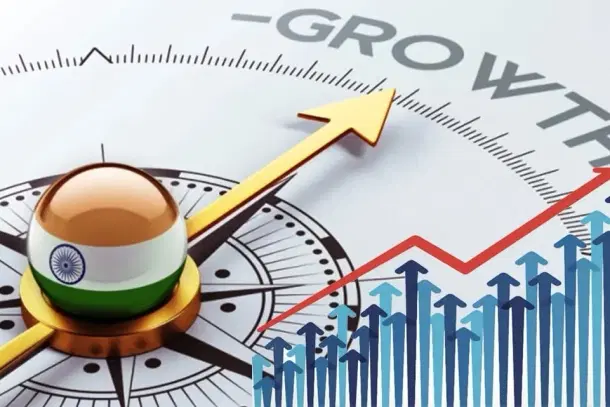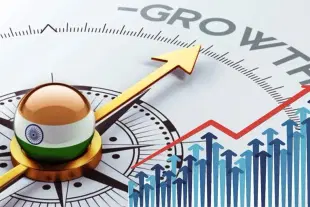Economy
India's Q1 FY25-26 GDP Growth: Unpacking The Surprise
Pramod Hegde
Aug 30, 2025, 11:50 AM | Updated Aug 31, 2025, 11:25 AM IST
Save & read from anywhere!
Bookmark stories for easy access on any device or the Swarajya app.


India’s economy has once again outperformed expectations, delivering an impressive GDP growth of approximately 7.8% in Q1 FY25-26 (April-June 2025), surpassing the expectations by around 100 basis points (bps). The GDP forecasts for the quarter broadly ranged between 6.5-7%.
While one can easily get an idea of the various components of GDP that drove the growth from the press release and associated news articles, it is useful to examine certain other data points to make sense of the numbers and assess what may lie ahead.
Core Indicators: A Mixed Bag
Over the longer term, core economic indicators such as cement, steel production, petroleum consumption, and electricity demand serve as reliable proxies for economic growth. However, quarterly data can be distorted by transient factors, and Q1 FY25-26 is no exception.
Cement and steel production (a key indicator for fixed capital investments) recorded robust growth of 7-8%, reflecting sustained momentum in infrastructure development.
This was a key driver of the GDP upside in Q1. It aligns with the government’s continued emphasis on capital expenditure, which has bolstered economic activity. Some of this may have been contributed by the high growth in government capex in Q1, due to a low base in the June 2024 quarter which was impacted by the General Elections.
In contrast, petroleum consumption has remained nearly stagnant, with average growth of around 2.5% over the past five quarters and only 1.2% in Q1 FY25-26. This lacklustre performance suggests underlying softness in industrial or consumer demand, tempering the growth narrative.
Electricity consumption, typically a strong indicator, is less reliable this quarter due to weather anomalies. Rainfall in Q1 FY25-26 was approximately 30% above normal, likely reducing demand for cooling compared to Q1 FY24-25, which saw below-normal rainfall. This distortion renders electricity growth an unreliable metric for this period.
Other Indicators: Signs of Stability, Not a Boom
To gain a better perspective, it is helpful to examine other high-frequency indicators that provide additional context for the economy’s performance.
Goods and Services Tax (GST) collections, both with and without imports, have been relatively stable. A surge in GST receipts in May 2025 drove growth to levels that match or exceed nominal GDP growth, signalling some robustness in economic activity and improved tax compliance.
According to Reserve Bank of India (RBI) data, corporate Gross Value Added (GVA) for non-financial listed companies in nominal terms for Q1 FY25-26 was lower than both Q1 and Q4 of FY24-25 but significantly stronger than the weak Q2 FY24-25. In real terms, considering lower inflation during the June 2025 quarter, corporate GVA remained comparable to Q4 FY24-25, indicating stability but not exceptional dynamism.
Nielsen’s FMCG volume growth rose to 6% in Q1 FY25-26, largely driven by smaller players and rural areas, up from 5% in Q4 FY24-25, reflecting a modest uptick in consumer spending. Similarly, retail vehicle sales, which were stagnant in Q4 FY24-25, grew by 5% in Q1 in volume terms. While these figures suggest steady demand, they fall short of signalling any consumption boom.
Gross direct tax collections have remained flat, casting doubt on the narrative of a vibrant economy. This could be partly attributed to recent income tax cuts and the extension of the tax return filing deadline from 31 July to 15 September 2025, which likely delayed collections.
What Powered the GDP Surprise?
Some transient factors contributed to the stronger-than-expected GDP growth in Q1 FY25-26.
Real government consumption growth surged to 7.5% in Q1 FY25-26, a sharp rise from 2% in FY24-25 and a negative reading in Q1 and Q4 FY24-25. This was possibly due to low base effects. The increase likely added approximately 50 bps to overall GDP growth.
In FY24-25, manufacturing GVA and the Index of Industrial Production (IIP) tracked closely, both averaging around 4-4.5%. In Q1 FY25-26, however, manufacturing GVA surged to 7.7%, while IIP growth lagged at 3.3%. This divergence was possibly driven by a nearly 20% decline in global oil prices, which boosted manufacturing margins and added an estimated 50-60 bps to GDP growth.
Looking Ahead: Can the Momentum Hold?
While the headline GDP growth of 7.6% for the first half of calendar year 2025 is encouraging, high-frequency indicators for July 2025 suggest an economy that is moving along but not booming. The strong GDP prints in Q1 FY25-26 and Q4 FY24-25 are a testament to India’s economic resilience, but they should not breed complacency and derail the proposed deregulations and GST 2.0, which are steps in the right direction.
One-off factors, such as lower oil prices and higher government consumption, have flattered the numbers, masking underlying weaknesses in key indicators like petroleum consumption and direct tax collections. Moreover, looming tariff impacts could pose challenges to exports, employment, and industrial activity in the coming quarters.
Looking ahead to Q2 FY25-26 (July-September 2025), there is reason to expect the positive momentum to continue, considering the weak September 2024 quarter which was affected by the General Elections. However, this is expected to reverse in the second half of FY25-26, potentially leading to slower growth unless offset by other drivers.
Achieving the Viksit Bharat vision, a developed, inclusive, and prosperous India by 2047, requires consistent growth of 8%, coupled with job creation and equitable development.
The current trajectory falls short of the transformative pace needed. To bridge this gap, policymakers must double down on reforms, streamline regulations, enhance infrastructure, and foster an environment conducive to investment and innovation.
To sustain growth, the government must implement structural reforms, particularly in improving the ease of doing business and reducing compliance burdens for enterprises.
Pramod Hegde is Vice-President at a Big-4 Accounting Firm.





